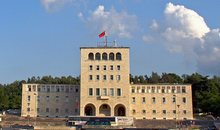
 Flash News
Flash News
Suspected of being murdered, photo emerges of 23-year-old found dead in Shkopet lake
Theth action, resident in tears: I built on my land with my life's expenses, the state should not destroy it
Directors targeted! After Fier and Durrës, Rama arrives in Elbasan
Name/Identification of the 23-year-old found dead near Shkopet Lake
IKM action in Theth, residents come out in protest
"Part of the global chain", time for Albanian business to increase the use of information technology

The challenges of the open market and being part of the global chain face businesses with a growing competition and therefore it is vital, not only to increase productivity and improve product quality, but also the speed of movement of information within the business. It is already a reality that the realization of managerial functions requires not only the availability of all the necessary information, but above all a good management of the flow of information, which is generated by different directions within a firm.
Moreover, Albanian policy-making and business will have to objectively and realistically assess the challenges and costs of Albania's integration processes in the European Community. In general, the information on these costs is minimalist, especially the one addressed to the business. This process, for many subjects, will be "painful" and will require major transformations in all directions. Those who will suffer the most are especially the medium and small enterprises of the country.
In this perspective, an observation was carried out which enabled the addressing of three aspects: what is the digitization of managerial functions; why it is a necessary process, and how we should measure it and understand if a business is digitized and to what degree it is digitized. Recently, funding is being increased for the gradual transformation of Albanian businesses, competitively able to enter the European market. They are mainly being offered as funds for start-ups as well as for research purposes.
In this context, in a collaboration of the Mediterranean University of Albania with the Union of Albanian Manufacturers, it is intended to identify the degree of "smart" use of information systems for the realization of managerial functions in some Albanian manufacturing businesses and to evaluate their digitization rate.
Entering a market means operating with the rules of this market, and for this you must not only know economic laws, but also realize conceptual changes in business management, technological changes in managerial decision-making and, above all, strategic changes in building business development policies.
Through direct observations and interviews that were carried out in small and medium-sized businesses, during the diagnostic phase, it was possible to perceive how the digitalization process was conceived by the businesses themselves and, to some extent, their knowledge of Industry 4.0 (since all businesses were manufacturing). During this process, several problems were identified, which should receive increased attention from the business side, academics and policy making.
The transformation and transition to integrated information systems and "awakened" use by management is a process that businesses must necessarily build in order to be more competitive in the new conditions of an increasingly digital global market.
So, the way of management, decision-making, data analysis and interaction that were carried out five years ago cannot be applied even today, or rather they should be changed in function of a decision-making based as much as possible on numbers and dynamic analysis. More and more objective decision-making should be aimed for, in real time with analytical data.
This means more integrated digital systems that generate the right information for managers, more people who know how to use them and more time for strategic development decisions. In this way, the same business, with almost the same costs, with the same people, but better trained, can transform its activity and make it able to compete in any market and face any competitor.
What prevents the digitization of Albanian businesses?
The first question that everyone asks and which is a constant debate between universities and businesses is: what prevents the digitalization of Albanian businesses? Without lingering too much on this point that has endless discussions, the study revealed that in addition to economic elements, there are potentially two factors that inhibit this process: first, the force of habit or more precisely the daily work routine, and second , poor time management by managers and business owners themselves.
Many leaders or owners of successful businesses to date, facing relatively little competition and operating in a limited market, think that if they have been doing well with this method for 30 years, why not continue to do so? for another 10 years.
This is even more evident in cases where the second generation of the family has not fully entered into the general practice of the business, but enjoys the fruits of the earlier generations. The second factor is related to the management of working time by managers and business owners. In 90% of their working time, they solve operational problems, without having time to sit down and discuss strategic decisions.
For most of them, it is much more important to solve immediate problems than long-term ones. Moreover, modernization of decision-making processes is rarely thought of, especially when business is going well.
In a few businesses, long-term development plans were clearly analyzed and with appropriate resources and gradually implemented. Most of them were for tools and machinery while a very small part was for management systems.
In order to identify the level of use of information technology and the degree of integration of IT in managerial activity, it was possible to assess with concrete numbers the degree of digitization of the management of some of the main areas of activity, including production, storage, sales, the use of material and human resources and some other areas.
The methodology used allowed through interviews and observation in work environments to directly identify the perception that managers and owners had about the degree of digitization in each of the areas included in the study. On the other hand, the perception is compared with the findings generated by the detailed concrete questions for each area.
Thus, for example, in order to evaluate the information systems for financial management, it was evident that due to fiscalization, all businesses had accounting programs that primarily completed the preparation of financial information for the effect of tax liability, as well as generating a lot of interesting data. for other elements of management systems, such as warehouse, sales, costs, etc.
While the perception of the owners and/or managers was that they had a high degree of accounting digitization in their business, on the other hand, when the situation was detailed in concrete data, such as cost centers, the life cycle of a product, digital traces in real time of goods or raw materials in the warehouse, they realized that their level was not very high.
In this context, from the preliminary diagnosis, all the studied enterprises were divided into two groups: in the first group, those enterprises where the perception of digitization was higher than the real one, measured by numbers, and in the other group, those that were aware that they had a lot of work to do for digitization, because their perception was lower than the measured one.
This simple part of the diagnosis made it possible to identify that the businesses that had a more realistic conception of digitization also had written investment plans, at least for the three-year period, and constantly invested in building programs to generate the most accurate and necessary data. for their decision making. These were mainly companies that had new machines and had collaborations with European companies in the same sector.
In the other group of businesses, two main problems were identified, especially in the digitization of the production process. Since the investments were made piecemeal, according to the requests or contracts they had at different stages, the unification of production and the communication of machines between them or between departments was very difficult.
On the other hand, some businesses seeking to switch to a closed cycle, due to the lack of raw material in the country in the right amount, were forced to import raw material, which had different qualities than that produced in the country and the machines had different yields. Also, the diagnostic phase attracted interest from businesses for two other elements. The first was related to the analysis of their websites, analyzing not only the functional elements, but also the architectural ones and making concrete suggestions for their adjustment.
The other element was related to workforce assessment and development. All businesses were suggested to measure employee satisfaction in the workplace, as they generally found it useful, but none had done such an assessment. The recommendation consisted in the fact that by analyzing the results of this test, employees could become more interested in advancing in the workplace and, above all, in increasing work productivity.
Through the modest presentation of some of the findings of the study, it is emphasized how vital it is that both businesses and politics understand that the transition to the large European market is an important process that affects both the market itself and the political elements of a country. The sooner business and all other actors become aware of this, the easier it will be for them to interact and prepare to face the costs of integration into the European market./ Monitor
Latest news



Found dead in Shkopet Lake, 23-year-old has injuries to his throat
2025-07-09 10:41:39


Hoxha: We will have a parliament that will surpass any comedy program!
2025-07-09 10:10:32

Directors targeted! After Fier and Durrës, Rama arrives in Elbasan
2025-07-09 09:53:57
Name/Identification of the 23-year-old found dead near Shkopet Lake
2025-07-09 09:42:34
IKM action in Theth, residents come out in protest
2025-07-09 09:34:54
Reasons why the EU has not imposed new sanctions against Russia
2025-07-09 09:18:35
DW: Online scams increase human trafficking
2025-07-09 09:01:29

Reported missing by his father, 23-year-old found dead near Shkopet lake
2025-07-09 08:42:13

Horoscope, what do the stars have in store for you today?
2025-07-09 08:25:44
Sun and rain, Wednesday with unstable weather
2025-07-09 08:06:58
Posta e mëngjesit/ Me 2 rreshta: Çfarë pati rëndësi dje në Shqipëri
2025-07-09 07:52:02

Tabaku: Salianji bore a political cost that no one in Albania has borne
2025-07-08 22:36:15


Sekretet për të shijuar verën si një ‘profesionist’
2025-07-08 21:45:06


Albania's Waste Crisis: Toxic Smoke and Deep Governance Problems
2025-07-08 21:13:07
Alarming pollution in Fushë-Arrëz, copper factory waste turns the Fan River red
2025-07-08 21:07:14

Poll/ How do you assess the Prime Minister's intervention in local government?
2025-07-08 20:40:01
28 arrested in Italy and Spain for drug trafficking, including an Albanian
2025-07-08 20:24:14
Residents clash with police in Theth: We are on our land
2025-07-08 20:11:41
Death of 27-year-old in Lipjan, Osmani: To be investigated independently!
2025-07-08 20:06:52
Trump promises US will send more weapons to Ukraine
2025-07-08 19:54:25

EU targets health, education, police and cadastre as areas of corruption
2025-07-08 19:23:34




Salianji after his return: I did not oppose for functions, but for vocation
2025-07-08 18:23:15
Will he run in the 2029 elections? Here's how Salianji answers
2025-07-08 18:16:09
Boat captain drowns after diving into water to save two tourists in Shkodra
2025-07-08 18:05:12
Salianji from the DP headquarters: I brought a drug trafficker to justice
2025-07-08 18:03:26
After Fier, Rama "landes" in Durrës, dismissals expected
2025-07-08 17:53:32
Ervin Salianji arrives at the blue headquarters, welcomed by supporters
2025-07-08 17:45:12

EU approves final steps for Bulgaria's Eurozone membership
2025-07-08 17:43:06

Zhupa after Salianj's release: Inspiration for every opposition member
2025-07-08 17:19:39
Actor David Killick passes away
2025-07-08 17:09:23



Threatened with dismissals, Rama arrives at the Fier municipality
2025-07-08 16:39:19
Extreme temperatures temporarily close Acropolis in Greece
2025-07-08 16:30:34

A plot of cannabis is discovered in Mazha, Kruja
2025-07-08 16:13:48

Republika Srpska allocates additional 22 million euros for lobbying in the US
2025-07-08 15:52:04

Spices that protect you from mosquitoes!
2025-07-08 15:30:03

Accident on the Vlora-Qeparo axis, one injured
2025-07-08 15:11:52
Berat, 17 years part of UNESCO's world heritage
2025-07-08 15:03:30


Cost of living increases, inflation rises to 2.4% in June, driven by food
2025-07-08 14:29:54
VIDEO/ Restaurant roof collapses in Italy, one victim and ten injured
2025-07-08 14:18:44
Requested release from cell, Supreme Court leaves Veliaj in prison
2025-07-08 14:07:41
TikTok shutdown/ Austrian media: Rama benefited politically from the app ban
2025-07-08 13:48:25
Acropolis temporarily closed due to heat
2025-07-08 13:31:09



Salianj's release/Berisha: He was politically condemned by Rama and Xhafa!
2025-07-08 13:00:13

Knife attack on Peshkopia Boulevard
2025-07-08 12:44:10


Fier Court decides on the conditional release of Ervin Salianj
2025-07-08 12:15:23
Cost of living increases, inflation rises to 2.4% in June due to food
2025-07-08 12:00:16


Requesting conditional release, Ervin Salianji arrives at the Fier Court
2025-07-08 11:16:36
The first phase of university applications begins today
2025-07-08 11:10:52
Fire in Lura, flames endanger the National Park
2025-07-08 10:53:43
Trump warns of 35% tariffs on Serbia and 30% on Bosnia and Herzegovina
2025-07-08 10:37:32
Thethi rooster and the dung cock
2025-07-08 10:24:01

Fire in Dukat endangers Llogara National Park
2025-07-08 10:01:39
International drug search: 36-year-old arrested in Durrës (NAME)
2025-07-08 09:50:48
Thethi, tourists "criticize" modern trend
2025-07-08 09:39:54
Fire on Mount Dukat still active, Llogara National Park at risk
2025-07-08 09:28:12
Veliaj's appeal to be heard today in the High Court
2025-07-08 09:16:02
"Bad sign for democracy"/ Parliament neglects reporting by institutions
2025-07-08 09:04:56
Today's hearing at the Fier Court, Salianji requests conditional release
2025-07-08 08:56:39


Horoscope, what do the stars have in store for you today?
2025-07-08 08:16:19
